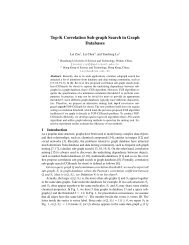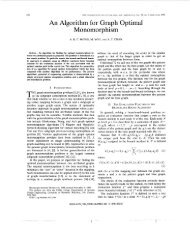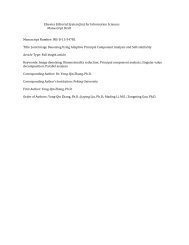Construction Time (ms)48403224Constr. TimeQuery Time65605550Query Time (ms)Construction Time (sec)75604530Constr. TimeQuery Time3.532.52Query Time (sec)Construction Time (sec)500400300200Constr. TimeQuery Time3000250020001500Query Time (sec)16452 3 4 5Number of Traversals151.52 3 4 5Number of Traversals10010002 3 4 5Number of Traversals(a) (b) (c)Figure 3: Effect of Increasing Number of Intervals: (a) ecoo, (b) cit-patents, (c) rand10m10xDataset <strong>GRAIL</strong> DFS HLSS INT Dual PT 3HOP #Pos.Qagrocyc 57 44 71 158 65 8 235 133amaze 764 1761 99 101 63 7 4621 17259anthra 49 40 68 157 65 8.5 139 97ecoo 56 52 69 160 65 8.0 241 129human 80 36 81 238 77 14 –(t) 12kegg 1063 2181 104 100 72 7.1 81 20133mtbrv 49 55 81 144 75 7.2 218 175nasa 26.5 138 96 121 80 7.8 79 562vchocyc 49.6 56 76 145 79 7.2 206 169xmark 79 390 86 119 92 8.2 570 1482Table 8: Small Sparse <strong>Graphs</strong>: Query Time (ms)Datasets <strong>GRAIL</strong> HLSS INT Dual PT 3HOPagrocyc 50736 40097 27100 58552 39027 87305amaze 14840 17110 10356 433345 12701 1425Kanthra 49996 33532 26310 37378 38250 58796ecoo 50480 34285 26986 58290 38863 97788human 155244 109962 79272 54678 117396 –(t)kegg 14468 17427 10242 504K 12554 10146mtbrv 38408 30491 20576 41689 29627 74378nasa 22420 20976 18324 5307 21894 28110vchocyc 37964 30182 20366 26330 29310 75957xmark 24320 23814 16474 16434 20596 14892Table 9: Small Sparse <strong>Graphs</strong>: <strong>Index</strong> Size (Num. Entries)Dataset <strong>GRAIL</strong> HLSS INT Dual PT 3HOParxiv 21.7 – (t) 20317 450761 9639 – (t)citeseer 43.1 120993 7682 26118 751.5 113075go 9.5 69063 1144 4116 220.9 30070pubmed 43.9 146807 7236 27968 774.0 168223yago 18.2 28487 2627 4928 512 39066Table 10: Small Dense <strong>Graphs</strong>: Construction Time (ms)Dataset <strong>GRAIL</strong> DFS HLSS INT Dual PT 3HOP #Pos.Qarxiv 575 12179 –(t) 273 281 24.4 –(t) 15459citeseer 82.6 408 328 227 141 24.5 263 388go 51.4 127 273 151 136 11.6 104 241pubmed 75.5 375 315 254 132 22.1 264 690yago 46.9 121 258 181 88.4 13.8 157 171Table 11: Small Dense <strong>Graphs</strong>: Query Time (ms)Dataset <strong>GRAIL</strong> HLSS INT Dual PT 3HOParxiv 24000 –(t) 145668 3695K 86855 –(t)citeseer 64320 114088 142632 426128 91820 74940go 27172 60287 40644 60342 37729 43339pubmed 72000 102946 181260 603437 107915 93289yago 26568 57003 57390 79047 39181 36274Table 12: Small Dense <strong>Graphs</strong>: <strong>Index</strong> Size (Num. Entries)PathTree is very effective as well. 3HOP could not run on human.In terms of query time, PathTree is the best; it is 3-100 times fasterthan <strong>GRAIL</strong>, and typically 10 times faster than HLSS and Dual.INT is not very effective, and neither is 3HOP. However, it is worthnoting that DFS gives reasonable query per<strong>for</strong>mance, often fasterthan indexing methods, other than PathTree and <strong>GRAIL</strong>. Given thefact that DFS has no construction time or indexing size overhead, itis quite attractive <strong>for</strong> these small datasets. The other methods havecomparable index sizes, though INT has the smallest sizes.On the small dense datasets, 3HOP and HLSS could not run onarxiv. <strong>GRAIL</strong> (with d = 2) has the smallest construction timesand index size of all indexing methods. It is also 2-20 times fasterthan a pure DFS search in terms of query times, but is 3-20 timesslower than PathTree. Even on the dense datasets the pure DFS isquite acceptable, though indexing does deliver significant benefitsin terms of query time per<strong>for</strong>mance.As observed <strong>for</strong> amaze and kegg (Table 8), and <strong>for</strong> arxiv(Table 11), the query time <strong>for</strong> <strong>GRAIL</strong> increases as the number ofreachable node-pairs (#PosQ) increase in the query set. However,the graph topology also has an influence on the query per<strong>for</strong>mance.Small-sparse datasets, such as kegg and amaze, have a centralnode with a very high in-degree and out-degree. For such graphs,<strong>for</strong> many of the queries, <strong>GRAIL</strong> has to scan all the children of thiscentral node to arrive at the target node. This significantly increasesthe query time (line 7 in Algorithm 2). To alleviate this problem,one possibility is that nodes with large out-degree could keep theintervals of their children in a spatial index (e.g. R-Trees) to acceleratetarget node/branch lookup.Dataset Construction (ms) Query Time (ms) <strong>Index</strong> Size<strong>GRAIL</strong> <strong>GRAIL</strong> DFS <strong>GRAIL</strong>cit-patents 61911.9 1579.9 43535.9 37747680citeseer 1756.2 94.9 56.6 2775788citeseerx 19836 12496.6 198422.8 26272704go-uniprot 32678.7 194.1 391.6 27871824uniprot22m 5192.7 132.3 44.7 6381776uniprot100m 58858.2 186.1 77.2 64349180uniprot150m 96618 183 87.7 100150400Table 13: <strong>Large</strong> Real <strong>Graphs</strong>Constr. (ms) Query Time (ms) <strong>Index</strong> SizeSize Deg. <strong>GRAIL</strong> <strong>GRAIL</strong> DFS <strong>GRAIL</strong>2 128796 187.2 577.6 100Mrand10m 5 226671 5823.9 90505 100M10 407158 1415296.1 –(t) 100Mrand100m2 1169601 258.2 762.7 800M5 1084848 20467 131306 400MTable 14: Scalability: <strong>Large</strong> Synthetic <strong>Graphs</strong>4.3 <strong>Large</strong> Datasets: Real and SyntheticTable 13 shows the construction time, query time, and index size<strong>for</strong> <strong>GRAIL</strong> (d = 5) and pure DFS, on the large real datasets.We also ran PathTree, but un<strong>for</strong>tunately, on cit-patents andciteseerx is aborted with a memory limit error (–(m)), whereas<strong>for</strong> the other datasets it exceeded the 20M ms time limit (–(t)). It
was able to run only on citeseer data (130406 ms <strong>for</strong> construction,47.4 ms <strong>for</strong> querying, and the index size was 2360732 entries).On these large datasets, none of the other indexing methods couldrun. <strong>GRAIL</strong> on the other hand can easily scale to large datasets,the only limitation being that it does not yet process disk-residentgraphs. We can see that <strong>GRAIL</strong> outper<strong>for</strong>ms pure DFS by 2-27times on the denser graphs: go-uniprot, cit-patents, andciteseerx. On the other datasets, that are very sparse, pure DFScan in fact be up to 3 times faster.We also tested the scalability <strong>for</strong> <strong>GRAIL</strong> (with d = 5) on thelarge synthetic graphs. Table 14 shows the construction time, querytime and index sizes <strong>for</strong> <strong>GRAIL</strong> and DFS. Once again, none of theother indexing methods could handle these large graphs. PathTreetoo aborted on all datasets, except <strong>for</strong> rand10m2x with avg. degree2 (it took 537019 ms <strong>for</strong> construction, 211.7 ms <strong>for</strong> querying,and its index size was 69378979 entries). We can see that <strong>for</strong>these datasets <strong>GRAIL</strong> is uni<strong>for</strong>mly better than DFS in all cases. Itsquery time is 3-15 times faster than DFS. In fact on rand10m10xdataset with average density 10, DFS could not finish in the allocated20M ms time limit. Once again, we conclude that <strong>GRAIL</strong>is the most scalable reachability index <strong>for</strong> large graphs, especiallywith increasing density.Dataset Constr. Time (ms) Query Time (ms) <strong>Index</strong> Size (# Entries)with E w/o E with E w/o E Label Exceptionsamaze 1930.2 3.8 454.2 758.1 22260 19701human 24235.5 134.5 596.4 81.1 310488 11486kegg 2320.3 6.4 404.3 1055.1 28936 18385arxiv 64913.2 53.7 532.4 424.99 60000 3754315Table 15: <strong>GRAIL</strong>: Effect of Exceptions4.4 <strong>GRAIL</strong>: SensitivityException Lists: Table 15 shows the effect of using exception listsin <strong>GRAIL</strong>: “with E” denotes the use of exception lists, where as“w/o E” denotes the default DFS search with pruning. We usedd = 3 <strong>for</strong> amaze, d = 4 <strong>for</strong> human and kegg (which are thesparse datasets), and d = 5 <strong>for</strong> arxiv. We can see that usingexceptions does help in some cases, but the added overhead of increasedconstruction time, and the large size overhead of storingexception lists (last column), do not justify the small gains. Furthermore,exceptions could not be constructed on the large real graphs.Number of Traversals/Intervals (d): In Figure 3 we plot the effectof increasing the dimensionality of the index, i.e., increasingthe number of traversals d, on one sparse (ecoo), one large real(cit-patents), and one large synthetic (rand10m10x) graph.Construction time is shown on the left y-axis, and query time onthe right y-axis. It is clear that increasing the number of intervalsincreases construction time, but yields decreasing query times.However, as shown <strong>for</strong> ecoo, increasingddoes not continue to decreasequery times, since at some point the overhead of checking alarger number of intervals negates the potential reduction in exceptions.That is why the query time increases from d = 4 to d = 5<strong>for</strong> ecoo. To estimate the number of traversals that minimize thequery time, or that optimize the index size/query time trade-off isnot straight<strong>for</strong>ward. However, <strong>for</strong> any practical benefits it is imperativeto keep the index size smaller than the graph size. This looseconstraint restricts d to be less than the average degree. In our experiments,we found out that the best query time is obtained whend = 5 or smaller (when the average degree is smaller). Other measuresbased on the reduction in the number of (direct) exceptionsper new traversal could also be designed.Effect of <strong>Reachability</strong>: For all of the experiments above, we issue100K random query pairs. However, since the graphs are verysparse, the vast majority of these pairs are not reachable. As an alternative,we generated 100K reachable pairs by simulating a randomwalk (start from a randomly selected source node, choose arandom child with 99% probability and proceed, or stop and reportthe node as target with 1% probability). Tables 16 and 17show the query time per<strong>for</strong>mance of <strong>GRAIL</strong> and pure DFS <strong>for</strong> the100K random and 100K only positive queries, on some small andlarge graphs. We used d = 2 <strong>for</strong> human, d = 4 <strong>for</strong> arxiv andd = 5 <strong>for</strong> the large graphs. The frequency distribution of numberof hops between source and target nodes <strong>for</strong> the queries is plotted inFigure 4. Generally speaking, querying only reachable pairs takeslonger (from 2-30 times) <strong>for</strong> both <strong>GRAIL</strong> and DFS. Note also that<strong>GRAIL</strong> is 2-4 times faster than DFS on positive queries, and up to30 times faster on the random ones.Dataset<strong>GRAIL</strong>RandomPositiveAvg σ Avg/σ Avg σ Avg/σhuman 80.4 23.5 0.292 1058.7 146.4 0.138arxiv 420.6 11.2 0.027 334.2 4.19 0.013cit-patents 1580.0 121.4 0.077 3266.4 178.2 0.055citeseerx 10275.5 3257.2 0.317 310393.2 14809 0.048rand10m5x 5824.0 363.6 0.062 19286.8 1009.8 0.052Table 16: Average Query Times and Standard DeviationDatasetDFSRandomPositiveAvg σ σ/Avg Avg σ σ/Avghuman 36.4 10.4 0.286 919.6 89.5 0.097arxiv 12179.6 179.1 0.014 1374.2 30.4 0.022cit-patents 43535.9 1081.3 0.008 6827.8 372.4 0.055citeseerx 198422.9 10064.3 0.051 650232.0 7411.4 0.011rand10m5x 90505.9 3303.2 0.036 49989.3 1726.9 0.035Table 17: Average Query Times and Standard DeviationEffect of Query Distribution: Tables 16 and 17 show the averagequery times and the standard deviation <strong>for</strong> <strong>GRAIL</strong> and DFS,respectively. Ten sets, each of 10K queries, are used to obtainthe mean and standard deviation of the query time. In randomquery sets when using <strong>GRAIL</strong> the coefficient of variation (CV –the ratio of the standard deviation to the mean) is between 1/3 and1/40, whereas it varies from 1/3 to 1/70 when using DFS. As expected,DFS has more uni<strong>for</strong>m query times compared to <strong>GRAIL</strong>because <strong>GRAIL</strong> can cut some queries short via pruning while inother queries <strong>GRAIL</strong> imitates DFS. However <strong>for</strong> query sets with allreachable (positive) node-pairs, CV decreases <strong>for</strong> <strong>GRAIL</strong> since thelikelihood of pruning and early termination of the query decreases.On the other hand, there is no such correlation <strong>for</strong> DFS.Number of Queries10 5 humanarxiv10 4cit-Patentsciteseerxrand10m5x10 310 210 110 00 3 6 9 12 15 18Number of Hops to TargetFigure 4: <strong>Reachability</strong>: Distribution of Number of HopsEffect of Density: We studied the effect of increasing edge densityof the graphs by generating random DAGs with 10 million nodes,and varying the average density from 2 to 10, as shown in Figure 5.As we can see, both the construction and query time increase with












